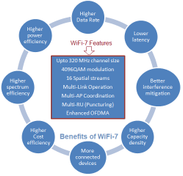Li-Fi vs. Wi-Fi: Key Differences in Internet Technologies
Advertisement
This article compares Li-Fi and Wi-Fi internet technologies, highlighting their fundamental differences. Li-Fi stands for Light Fidelity, while Wi-Fi stands for Wireless Fidelity.
Li-Fi utilizes light for data transmission, whereas Wi-Fi employs electromagnetic waves at radio frequencies.
Light experiences less interference than radio frequency waves, making Li-Fi suitable for dense environments. Li-Fi typically covers a distance of about 10 meters, while Wi-Fi can reach approximately 30 meters. Both technologies offer comparable data transfer rates.
Let’s delve into the network architectures of Li-Fi and Wi-Fi internet.
Li-Fi Internet Architecture
 Li-Fi internet architecture
Li-Fi internet architecture
Figure 1 illustrates the Li-Fi internet network architecture. It primarily consists of two key components:
- LED Lamp: Serves as the light source for data transmission.
- Li-Fi Dongle: Enables devices to connect to the Li-Fi network.
Here’s a breakdown of how it works:
- A lamp driver connects to the internet and to LED lamps. Streaming content from the internet is routed to the LED lamps via the lamp driver software.
- LED lamps are strategically placed throughout an office or home to serve multiple users.
- Users require a Li-Fi dongle to access the Li-Fi internet service on their devices. For example, Person #1 might use a laptop, Person #2 a tablet, and Person #3 a smartphone.
- The Li-Fi dongle includes a photodetector, amplification and processing circuitry, and applications to handle various data types.
- A power button switch controls the LED lamps.
- Li-Fi internet can achieve very high data rates, potentially reaching 1 Gbps.
Wi-Fi Internet Architecture
 wlan
wlan
Figure 2 depicts the Wi-Fi internet network architecture, which relies on:
- Wi-Fi Router: Acts as the central hub for the Wi-Fi network.
- Wi-Fi Dongle or Wi-Fi Stations: Allow devices to connect to the Wi-Fi network.
Here’s a summary of the Wi-Fi architecture:
- The Wi-Fi router connects to an ADSL modem or cable modem, which in turn connects to the internet service provider’s network.
- Wi-Fi routers operate on multiple frequency bands (e.g., 2.4 GHz, 4.9 GHz, or 5 GHz) depending on the requirements. They convert internet data packets into Wi-Fi compliant signals within these bands. Wi-Fi operates based on IEEE 802.11 standards.
- Wi-Fi dongles or Stations connected to IP-compatible devices receive these electromagnetic waves.
- In this way, various clients can access the internet via Wi-Fi as shown in figure 2.
Advertisement
 RF
RF

